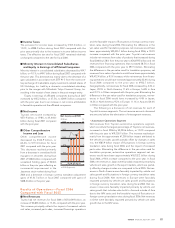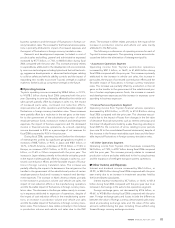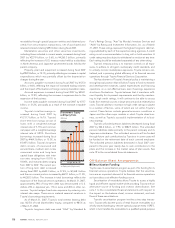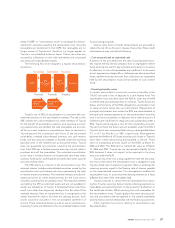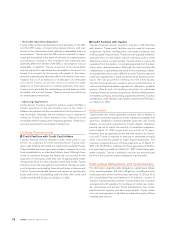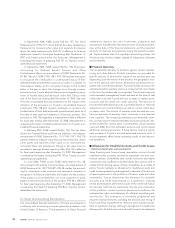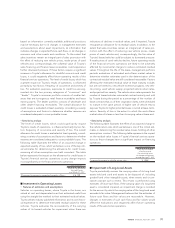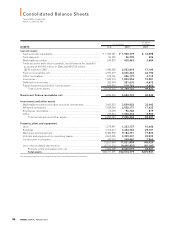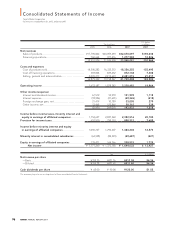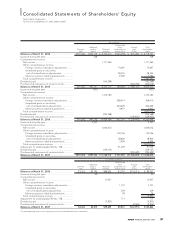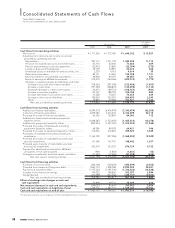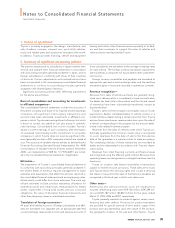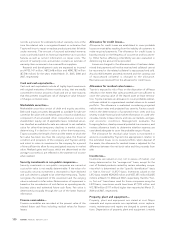Toyota 2007 Annual Report Download - page 92
Download and view the complete annual report
Please find page 92 of the 2007 Toyota annual report below. You can navigate through the pages in the report by either clicking on the pages listed below, or by using the keyword search tool below to find specific information within the annual report.
90 ANNUAL REPORT 2007
In September 2006, FASB issued FAS No. 157, Fair Value
Measurements ("FAS 157"), which defines fair value, establishes a
framework for measuring fair value and expands disclosures
about fair value measurements. FAS 157 is effective for financial
statements issued for fiscal year beginning after November 15,
2007 and interim period within the fiscal year. Management is
evaluating the impact of adopting FAS 157 on Toyota’s consoli-
dated financial statements.
In September 2006, FASB issued FAS No. 158, Employers’
Accounting for Defined Benefit Pension and Other
Postretirement Plans—an amendment of FASB Statements No.
87, 88, 106, and 132(R) ("FAS 158"). FAS 158 requires employers
to recognize the overfunded or underfunded status of their
defined benefit postretirement plans as an asset or a liability on
their balance sheets, and to recognize changes in that funded
status in the year in which the changes occur through compre-
hensive income. Toyota adopted the provisions regarding recog-
nition of funded status and disclosure under FAS 158 as of the
end of the fiscal year ending after December 15, 2006. See note
19 to the consolidated financial statements for the impact of the
adoption of the provisions on Toyota’s consolidated financial
statements. FAS 158 also requires employers to measure the
funded status of their defined benefit postretirement plans as of
the date of their year-end statement of financial position. This
provision in FAS 158 regarding a measurement date is effective
for fiscal year ending after December 15, 2008. Management is
evaluating the impact of adopting this provision on Toyota’s con-
solidated financial statements.
In February 2007, FASB issued FAS No. 159, The Fair Value
Option for Financial Assets and Financial Liabilities—Including an
amendment of FASB Statement No. 115 (“FAS 159”). FAS 159
permits entities to measure many financial instruments and certain
other assets and liabilities at fair value on an instrument-by-
instrument basis and subsequent change in fair value must be
recorded in earnings at each reporting date. FAS 159 is effective
for fiscal year beginning after November 15, 2007. Management
is evaluating the impact of adopting FAS 159 on Toyota’s consol-
idated financial statements.
In June 2006, FASB issued FASB Interpretation No. 48,
Accounting for Uncertainty in Income Taxes—an interpretation of
FASB Statement No. 109 (“FIN 48”). FIN 48 clarifies the account-
ing for uncertainty in tax positions and requires a company to
recognize in its financial statements, the impact of a tax position,
if that position is more likely than not to be sustained on audit,
based on the technical merits of the position. FIN 48 is effective
for fiscal year beginning after December 15, 2006. Management
is evaluating the impact of adopting FIN 48 on Toyota’s consoli-
dated financial statements.
Critical Accounting Estimates
The consolidated financial statements of Toyota are prepared in
conformity with accounting principles generally accepted in the
United States of America. The preparation of these financial
statements requires the use of estimates, judgments and
assumptions that affect the reported amounts of assets and liabil-
ities at the date of the financial statements and the reported
amounts of revenues and expenses during the periods present-
ed. Toyota believes that of its significant accounting policies, the
following may involve a higher degree of judgments, estimates
and complexity:
■Product Warranty
Toyota generally warrants its products against certain manufac-
turing and other defects. Product warranties are provided for
specific periods of time and/or usage of the product and vary
depending upon the nature of the product, the geographic loca-
tion of the sale and other factors. All product warranties are con-
sistent with commercial practices. Toyota provides a provision for
estimated product warranty costs as a component of cost of sales
at the time the related sale is recognized. The accrued warranty
costs represent management’s best estimate at the time of sale
of the total costs that Toyota will incur to repair or replace prod-
uct parts that fail while still under warranty. The amount of
accrued estimated warranty costs is primarily based on historical
experience as to product failures as well as current information
on repair costs. The amount of warranty costs accrued also con-
tains an estimate of warranty claim recoveries to be received
from suppliers. The foregoing evaluations are inherently uncer-
tain, as they require material estimates and some products’ war-
ranties extend for several years. Consequently, actual warranty
costs will differ from the estimated amounts and could require
additional warranty provisions. If these factors require a signifi-
cant increase in Toyota’s accrued estimated warranty costs, it
would negatively affect future operating results of the automo-
tive operations.
■Allowance for Doubtful Accounts and Credit Losses
• Natures of estimates and assumptions
Sales financing and finance lease receivables consist of retail
installment sales contracts secured by passenger cars and com-
mercial vehicles. Collectibility risks include consumer and dealer
insolvencies and insufficient collateral values (less costs to sell) to
realize the full carrying values of these receivables. As a matter of
policy, Toyota maintains an allowance for doubtful accounts and
credit losses representing management’s estimate of the amount
of asset impairment in the portfolios of finance, trade and other
receivables. Toyota determines the allowance for doubtful
accounts and credit losses based on a systematic, ongoing
review and evaluation performed as part of the credit-risk evalua-
tion process, historical loss experience, the size and composition
of the portfolios, current economic events and conditions, the
estimated fair value and adequacy of collateral and other perti-
nent factors. This evaluation is inherently judgmental and
requires material estimates, including the amounts and timing of
future cash flows expected to be received, which may be suscep-
tible to significant change. Although management considers the
allowance for doubtful accounts and credit losses to be adequate



